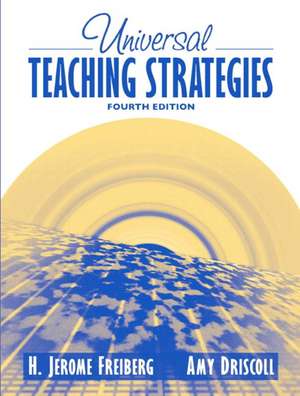Universal Teaching Strategies, MyLabSchool Edition
en Paperback – 22 dec 2004
This text presents teaching from three specific actions—organizing, instructing, and assessing—and is divided into three sections, which reflect each of these teaching actions. The strategies presented in each section are truly universal in nature—they cut across grade levels, subject areas, and teaching situations.
With clear and effective writing and a decision-making framework that combines the context, content, and learner with what teachers need in the real world—organizing, instructing, and assessing—Universal Teaching Strategies expands both the pedagogical teaching knowledge of teachers and their instructional repertoires.
Preț: 600.63 lei
Preț vechi: 780.05 lei
-23% Nou
Puncte Express: 901
Preț estimativ în valută:
114.97€ • 124.92$ • 96.63£
114.97€ • 124.92$ • 96.63£
Carte indisponibilă temporar
Doresc să fiu notificat când acest titlu va fi disponibil:
Se trimite...
Preluare comenzi: 021 569.72.76
Specificații
ISBN-13: 9780205464524
ISBN-10: 0205464521
Pagini: 528
Dimensiuni: 178 x 235 mm
Greutate: 0.9 kg
Ediția:4Nouă
Editura: ALLYN & BACON
Locul publicării:Boston, United States
ISBN-10: 0205464521
Pagini: 528
Dimensiuni: 178 x 235 mm
Greutate: 0.9 kg
Ediția:4Nouă
Editura: ALLYN & BACON
Locul publicării:Boston, United States
Cuprins
Most chapters begin with “Introduction” and end with “Summary,” “Reference(s),” and “Samples and Examples.”
PREFACE.
I. ORGANIZING STRATEGIES.
1. Teaching for Tomorrow: Context, Content, and Learners.
Universal Teaching Strategies.The Context of Teaching for Tomorrow.The Content of Teaching for Tomorrow.The Learners of Today and Tomorrow.Facing Tomorrow.2. Planning for Instruction: Visualizing What Could Be.
Three Voices of Planning.Functions of Planning.Planning Phases.Considerations for Planning.How Expert Teachers Plan.Lesson Planning Format.Sources of Information for Planning.Planning for Special Needs Learners.Labeling is Disabling .3. Designing Effective Instruction: Creating a Blueprint.
Models of Instructional Design.Designs for Varied Time Periods.Lesson Beginnings and Endings.Instructional Objectives.Instructional Design and Inclusion.Collaborative Planning and Designs.4. The Effective Use of Time: Doing More with Less.
Thinking about Time for Teaching and Learning.Time and the Inclusive Classroom.Time Savers.5. Classroom Management: Advancework.
Context Advancework.Content Advancework.Learner Advancework.Teachers as Tourists or Citizens.6. Classroom Management: Beyond Discipline.
Classroom Management Strategies.Models of Classroom Management.Smoothness and Momentum.Students with Special Needs.Classroom & Instructional Management Action Plan. II. INSTRUCTING STRATEGIES.
7. Lecture: From Passive to Active Learning.
Style without Substance.Learner, Context, and Content.Teacher Control.Teaching Note Taking.8. Questioning and Discussion: Creating a Dialogue.
Types of Questions.Cautions and Concerns.Classroom Discussion.Other Key Points.9. Interactive Practice for Learning: Beyond Drill.
Content.Context.Learner.Interactive Practice Strategies.10. Grouping for Instruction: Involvement and Interaction.
Implications for Grouping.Grouping for Teaching and Learning.11. Reflective Teaching and Learning: Students as Shareholders.
Context.Learner.Content.Reflective Teaching Strategies.12. Making Learning Real: Engaging Students in Content.
Context.Content.Learner.Teaching with Improvisation and Service Learning.Teaching Roles for Improvisation and Service Learning.13. Using Community Resources, Audiovisuals, Computers, and Multimedia: Varying the Stimuli.
Using Community Resources, Audiovisuals, Computers, and Multimedia.Audiovisual Stimuli.Technology. III. ASSESSING STRATEGIES.
14. Assessment of Learning: Let Me Count the Ways.
Purposes of Assessment.How to Assess Learning — Let Me Count the Ways.Assessment and Inclusion.Final Considerations for Assessment.15. Self-Improvement through Self-Assessment.
Self-Assessment: Creating Change from Within.Two Teachers Analyze Their Classrooms.Student Feedback.Student Feedback Instruments.Modified TEQ.Author Index.
Subject Index.
PREFACE.
I. ORGANIZING STRATEGIES.
1. Teaching for Tomorrow: Context, Content, and Learners.
Universal Teaching Strategies.The Context of Teaching for Tomorrow.The Content of Teaching for Tomorrow.The Learners of Today and Tomorrow.Facing Tomorrow.2. Planning for Instruction: Visualizing What Could Be.
Three Voices of Planning.Functions of Planning.Planning Phases.Considerations for Planning.How Expert Teachers Plan.Lesson Planning Format.Sources of Information for Planning.Planning for Special Needs Learners.Labeling is Disabling .3. Designing Effective Instruction: Creating a Blueprint.
Models of Instructional Design.Designs for Varied Time Periods.Lesson Beginnings and Endings.Instructional Objectives.Instructional Design and Inclusion.Collaborative Planning and Designs.4. The Effective Use of Time: Doing More with Less.
Thinking about Time for Teaching and Learning.Time and the Inclusive Classroom.Time Savers.5. Classroom Management: Advancework.
Context Advancework.Content Advancework.Learner Advancework.Teachers as Tourists or Citizens.6. Classroom Management: Beyond Discipline.
Classroom Management Strategies.Models of Classroom Management.Smoothness and Momentum.Students with Special Needs.Classroom & Instructional Management Action Plan. II. INSTRUCTING STRATEGIES.
7. Lecture: From Passive to Active Learning.
Style without Substance.Learner, Context, and Content.Teacher Control.Teaching Note Taking.8. Questioning and Discussion: Creating a Dialogue.
Types of Questions.Cautions and Concerns.Classroom Discussion.Other Key Points.9. Interactive Practice for Learning: Beyond Drill.
Content.Context.Learner.Interactive Practice Strategies.10. Grouping for Instruction: Involvement and Interaction.
Implications for Grouping.Grouping for Teaching and Learning.11. Reflective Teaching and Learning: Students as Shareholders.
Context.Learner.Content.Reflective Teaching Strategies.12. Making Learning Real: Engaging Students in Content.
Context.Content.Learner.Teaching with Improvisation and Service Learning.Teaching Roles for Improvisation and Service Learning.13. Using Community Resources, Audiovisuals, Computers, and Multimedia: Varying the Stimuli.
Using Community Resources, Audiovisuals, Computers, and Multimedia.Audiovisual Stimuli.Technology. III. ASSESSING STRATEGIES.
14. Assessment of Learning: Let Me Count the Ways.
Purposes of Assessment.How to Assess Learning — Let Me Count the Ways.Assessment and Inclusion.Final Considerations for Assessment.15. Self-Improvement through Self-Assessment.
Self-Assessment: Creating Change from Within.Two Teachers Analyze Their Classrooms.Student Feedback.Student Feedback Instruments.Modified TEQ.Author Index.
Subject Index.
Caracteristici
- “Research Vignettes”throughout the text provide basic information on research, which supports practice.
- “Snapshots”provide brief pictures of classroom scenes or teacher reflections of upcoming events to set the stage for upcoming topics.
- Cases established in the first chapter are carried throughout the text and allow the reader to view teaching through the eyes of real classroom teachers.
- Sections on special needs learners in each chapter address changing classroom dynamics.
- Samples and examples at the end of each chapter provide students and instructors with current classroom examples.
